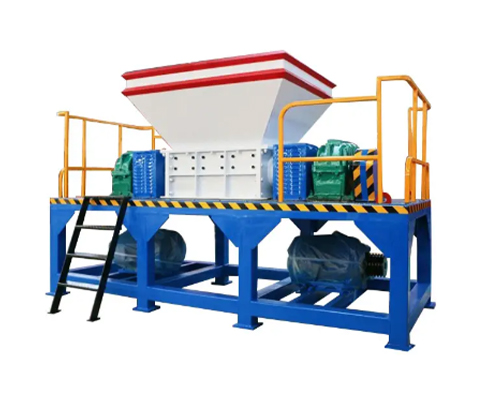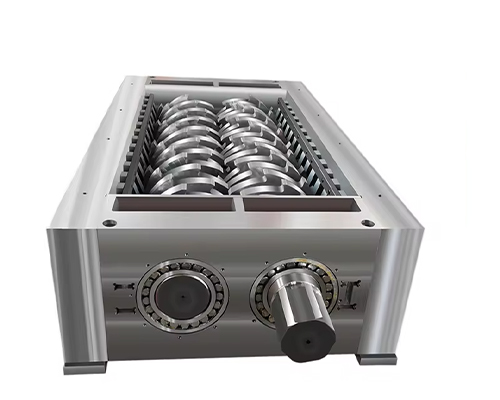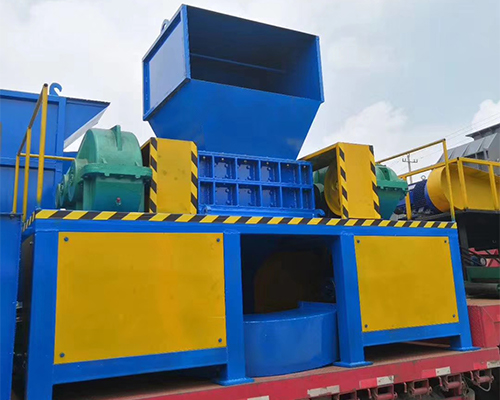Double-shaft shredder for construction waste
The double-shaft shredder is a mechanical device specially designed for processing various waste materials, especially for processing construction waste. It has two shafts that rotate against each other, and each shaft is equipped with a cutter. When the material enters the shredder, the cutters on the two shafts rotate in opposite directions, tearing the material into smaller pieces through shearing, stretching and squeezing.

For construction waste, such as a mixture of concrete blocks, bricks and tiles, wood, plastics and metals, the double-shaft shredder can effectively break it down into smaller particles for subsequent processing or recycling. This not only helps to reduce the amount of landfill, but also enables resources to be better recycled.

When operating a double-shaft shredder to process construction waste, the following points should be noted:
Safety measures: Ensure that the safety protection facilities around the equipment are intact, and the operator should wear appropriate labor protection supplies and have received professional training.
Feed control: Reasonably control the feed speed and size according to the capacity of the shredder, avoid overload operation, and prevent large hard objects from directly impacting the machine and causing damage.
Regular maintenance: Check the wear of the tool regularly and replace damaged parts in time; at the same time, the transmission system, lubrication system, etc. should also be maintained to ensure the normal operation of the equipment.
Environmental protection requirements: Dust and noise pollution may be generated during the processing process. Effective dust reduction and noise insulation measures must be taken to comply with local environmental protection regulations.
Classification and processing: Try to classify construction waste in advance, which can improve the shredding efficiency and facilitate the separation and recycling of different materials in the later stage.

In summary, the correct use of the double-shaft shredder can efficiently process construction waste and contribute to environmental protection and resource recycling.
| Model | 600 | 800 | 1000 | 1200 | 1400 | 1600 | 1800 |
| Motor(kw) | 11*2 | 18.5*2 | 35*2 | 45*2 | 55*2 | 75*2 | 110*2 |
Reducer | P6-P7 | P7-P8 | P8-P10 | P10-P12 | P11-P13 | P12-P16 | P14-P16 |
| Siemens or other motors, planetary reducers or other reducers can be customized according to customer requirements | |||||||
| Rotation Speed | 8-20rmp | 8-20rmp | 8-15rmp | 8-15rmp | 8-15rmp | 8-12rmp | 8-12rmp |
| Blades Diameter | 220-320 | 260-320 | 260-400 | 400-500 | 400-500 | 500 | 500 |
| Blades material | The material of the blades (55sicr, 5crsi, 9crsi, skd11, m6v, h13) can be customizedaccording to the customer's actual usage | ||||||
| Feeding Size | 1200*900mm | 1400*1000mm | 1600*1200mm | 1800*1300mm | 2000*1300mm | 2200*1700mm | 2400*2000mm |
| The size and appearance of the feeding hopper can be customized according to thecustomer's feeding situation | |||||||
| Weight(kg) | 1800 | 2500 | 3700 | 5500 | 7500 | 9500 | 13000 |
-
 Trommel screenTrommel screen, also known as drum screens, are widely used in various industries for sorting and separating materials.Get Quote
Trommel screenTrommel screen, also known as drum screens, are widely used in various industries for sorting and separating materials.Get Quote -
 Crop straw double shaft shreddApplications:Biomass Energy Production: Shredded straw can be used as a feedstock for bioenergy plants to produce electricity or heat.Livestock Feed: Reduced-si...Get Quote
Crop straw double shaft shreddApplications:Biomass Energy Production: Shredded straw can be used as a feedstock for bioenergy plants to produce electricity or heat.Livestock Feed: Reduced-si...Get Quote -
 Zhongcheng Air Drum SeparatorAir drum separators effectively separate lightweight materials (e.g., plastics, paper) from heavier materials (e.g., metals, glass). This high efficiency is cru...Get Quote
Zhongcheng Air Drum SeparatorAir drum separators effectively separate lightweight materials (e.g., plastics, paper) from heavier materials (e.g., metals, glass). This high efficiency is cru...Get Quote
-
2024-06-09Drum Screen RecyclingDrum screen machines are primarily used for material screening, helping to sort and recycle municipal solid waste and screen landfill waste. Their efficiency an...
-
2024-06-20Wind Separator Technology for Lightweight Materials in Urban Solid Wastewind separator, also known as air separation, is a sophisticated and efficient method of sorting that utilizes air as the separating medium.
-
2024-10-23Solid waste recycling plantOur company engaged in waste sorting system . We are professional about waste sorting system . We have professional technical team. Professional technical team...
-
2023-01-12Disc ScreenDisc screen, also known as a disc scalping screen, is a mechanical device used to separate materials based on size. It is commonly used in industries such as wa...
-
2024-05-20Mobile Impact Crusher PlantThe mobile impact crusher plant is a kind of crushing equipment based on a mobile platform. It uses an impact crusher as the host machine and is usually equippe...



